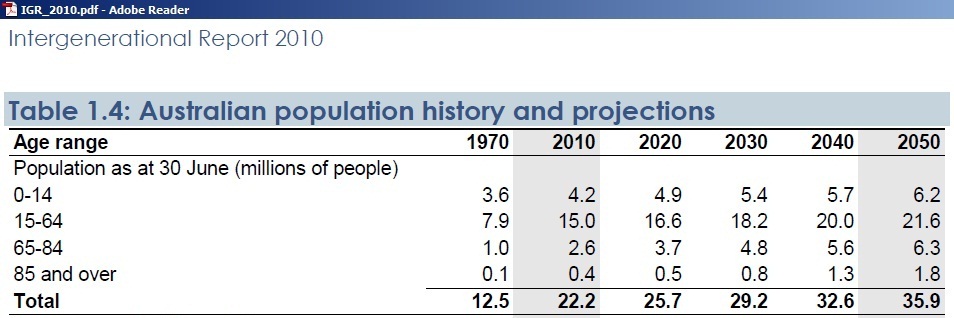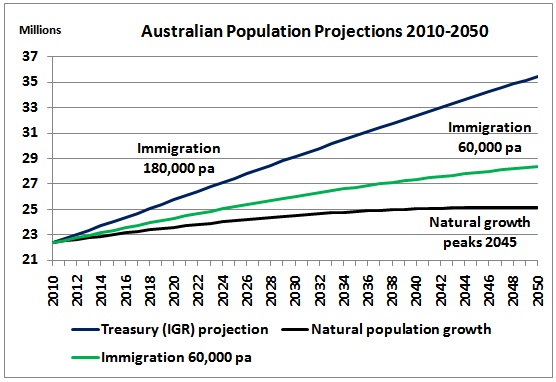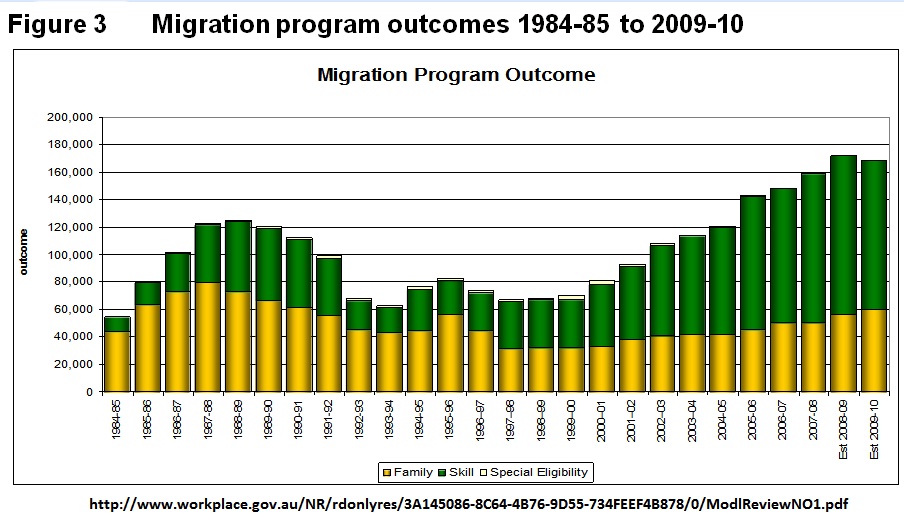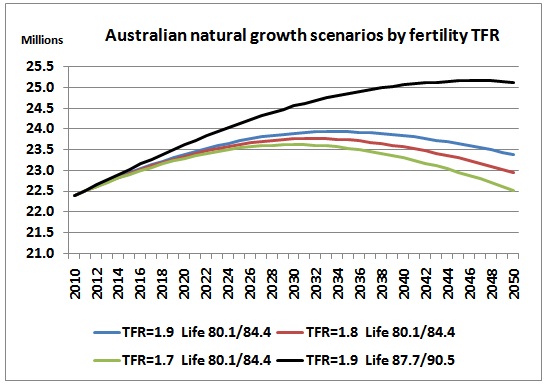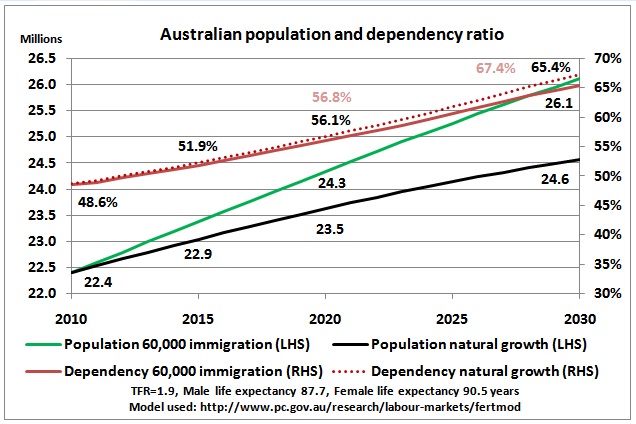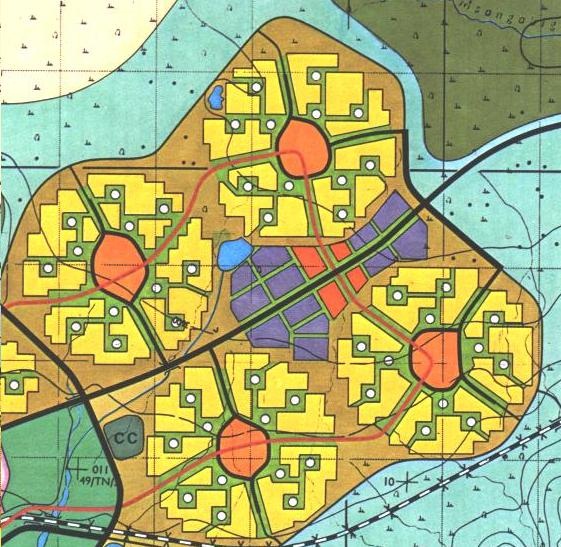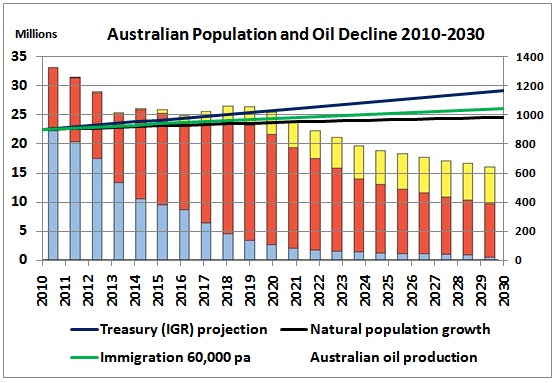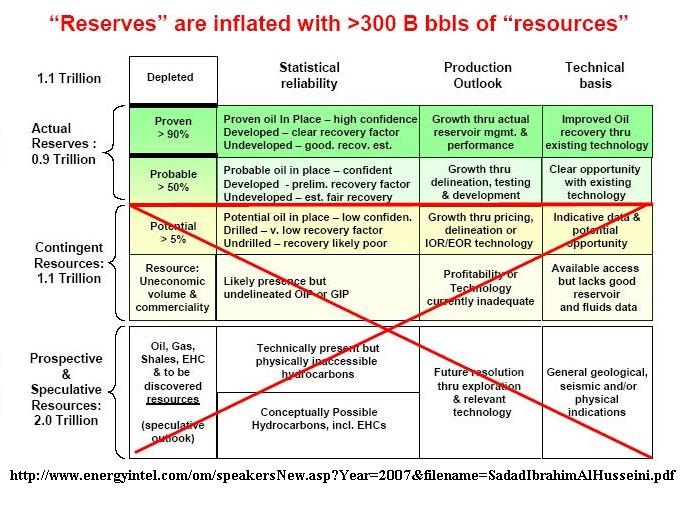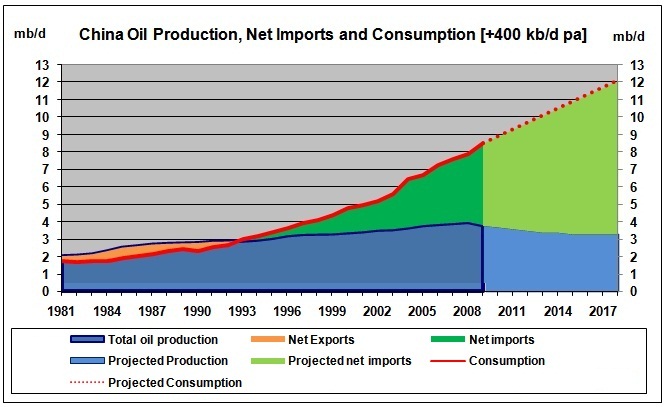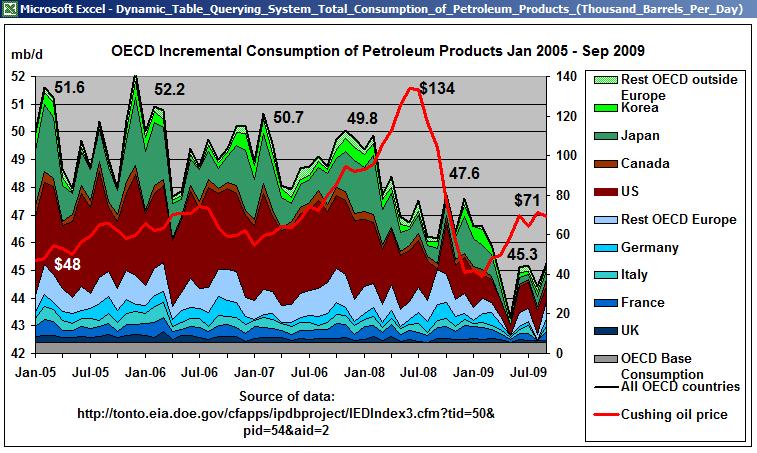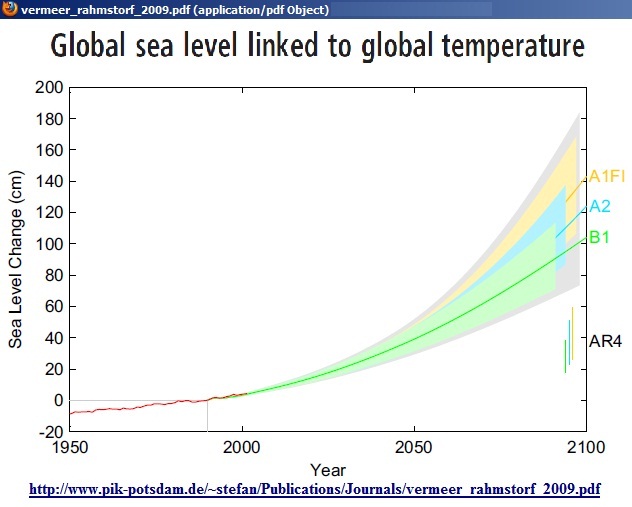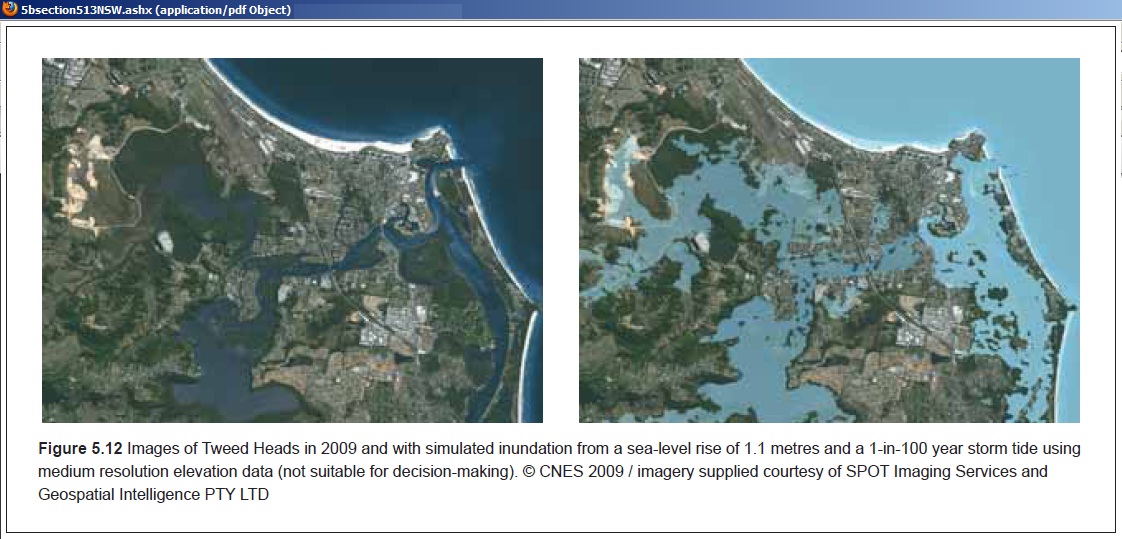Summary
The size of Australia’s future population growth including immigration will be largely determined by these events:
- Fuel shortages after peak oil which started in 2005
- Food shortages due to failure of governments to prepare for declining oil production
- Power shortages after global warming events will have forced us to abandon coal (2020)
- Sea level rises from global warming impacting an coastal cities
- Climate refugees settling in the North and starting agriculture there
The next oil crunch is predicted for 2012, which will see a replay of events in 2007/08. It will morph into a global oil crisis which will uncover the truth about OPEC’s paper barrels. This will trigger another financial melt-down, possibly also another peak oil war. At that point Australian motorists will understand that every new arrival will mean longer petrol lines at filling stations. That will be the end of a free choice in immigration levels.
The only given in future population development is natural population growth. Assuming current trends (fertility, improving life expectancy) and barring other unforeseen Black Swan events like bird flue etc. Australia’s existing population of 22 million will grow and peak between 2040 and 2050 at around 25 million. But even that is not certain. It is likely that life expectancy stays at present levels due to funding problems in the health system and heat waves from global warming. Under such an assumption population will peak between 2030 and 2040 at around 23.5 – 24 million depending on fertility rates.
Whatever immigration governments decide upon in the last years of free choice will add to the problems under (1) and (2) above. Assuming a recession type level of 60,000 pa. until 2020, the additional population to be planned for in the next 10 years is just 1.9 million in this coming decade.
The public should not be spin doctored into thinking, accepting and internalising that we are going to have a population growth bonanza, as pushed by the real estate industry. Although there are many uncertainties, one thing is for sure: the current population debate with a planning horizon of 2050 is totally academic.
Contents:
(1) Treasury’s projection in the Intergenerational Report
(2) Population pyramid showing the impact of past immigration
(3) Different scenarios: natural growth and 2 immigration levels
(4) Fertility and life expectancy scenarios
(5) Projections for the period up to 2020/2030
(6) Town Planning implications and sustainable cities
(7) Dependency ratios
(8) The population growth and oil decline gap
(9) Timeline of events in the next 10 years
(10) Mining boom will get stuck in peak oil
(11) Sea level rises
(12) Conclusion
———————
(1) Treasury’s Intergenerational Report 2010 contains a population projection of 35.9 million for 2050. Many have accepted, even internalised, this forecast as a given, in particular property developers who expect a huge growth bonanza. No one has checked:
- The underlying assumptions of immigration, fertility and life expectancies
- Peak oil and declining oil production
- Global warming and the impact on carbon based energy supplies and sea levels
http://www.treasury.gov.au/igr/igr2010/ The underlying assumptions are:
- a slightly reduced “past trend” projection into the future (1.4% pa reduced to 1.2%)
- an annual immigration of 180,000 pa
- a total fertility rate (TFR) of 1.9
- the life expectancy increasing from 80.1/84.4 years to 87.7/90.5 for males/females
(2) Let’s have a look at the Australian population pyramid (data from the Productivity Commission)
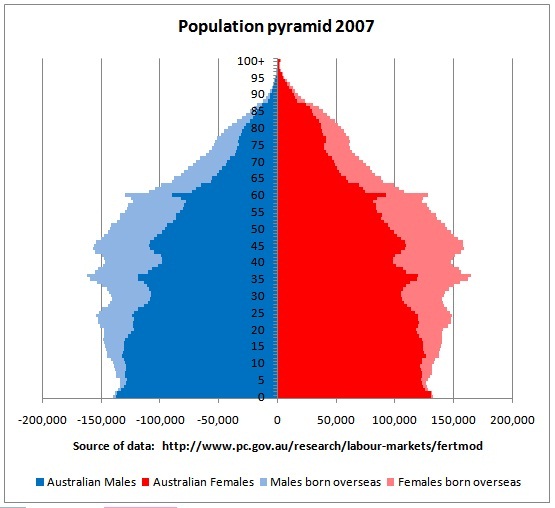 The lightly shaded areas represent Australians and residents born overseas. The immigration bulge will now move upwards and worsen the dependency ratio. This is the bill to be paid for earlier immigration which now leads to a premature aging because immigrants are fed sideways into the population pyramid, an unnatural process. The economic argument that younger immigrants reduce the average age of the population is static, but demography is about a dynamic process over time. The “core” Australian pyramid (solid colors) looks quite healthy (triangle shape) but at the price of that immigration bulge which brought up part of the bottom of the pyramid. Without immigration, the shape of the lower part of the pyramid would be vertical instead of slightly widening at its base.
The lightly shaded areas represent Australians and residents born overseas. The immigration bulge will now move upwards and worsen the dependency ratio. This is the bill to be paid for earlier immigration which now leads to a premature aging because immigrants are fed sideways into the population pyramid, an unnatural process. The economic argument that younger immigrants reduce the average age of the population is static, but demography is about a dynamic process over time. The “core” Australian pyramid (solid colors) looks quite healthy (triangle shape) but at the price of that immigration bulge which brought up part of the bottom of the pyramid. Without immigration, the shape of the lower part of the pyramid would be vertical instead of slightly widening at its base.
.
.
(3) Population scenarios
So how did Treasury arrive at that 35.9 million population by 2050? I am using the software FERTMOD of the Productivity Commission which can be found here:
http://www.pc.gov.au/research/labour-markets/fertmod
The starting population of FERTMOD is 21,017,222 for June 2007, which comes from here:
http://www.abs.gov.au/AUSSTATS/abs@.nsf/allprimarymainfeatures/F4204DD9DFDAFE6CCA257410000FF7FF?opendocument
In the meantime, population has grown and the starting population in June 2010 is calculated on the basis of this population clock (which includes overseas students)
http://www.abs.gov.au/AUSSTATS/abs@.nsf/Web+Pages/Population+Clock?opendocument
arriving at 22,403,000 in June 2010.
FERTMOD starts off with a hard coded net migration of 177,600 pa in 2007 (see VBA code for POPNOM(2) on page 27 of the documentation), close to the 180,000 in the Intergenerational Report IGR 2010, page 7).
Using the above IGR parameters (2), (3) and (4) one gets a perpetually growing population which would not stop to grow after 2050 even if immigration were set to zero at that time.
Of course we have no idea what will happen in all those decades, so this is a very theoretical exercise and that’s why the graph contains also other scenarios. The natural growth scenario (immigration = zero) peaks in 2047 at around 25 million.
A reduced immigration program at 60 K pa will not peak before 2050 and reaches 28 million then. Why 60,000? That was the immigration intake during the last recession in the early 90s:
(4) Fertility and Life expectancy scenarios
In the above 3 scenarios, all fertility and life expectancy parameters have been adopted from the IGR assumptions. But these may not materialize. For example, life expectancy may not go up in a period of declining oil production and in a warming climate with heat waves. Fertility rates may be reduced by housing shortages due to a continuing financial crisis or even food supply problems. The following graphs, therefore, show other, alternative scenarios.
We can see that the increase in life expectancy has quite a big impact on the size of the future population but that different fertility rates have a lesser impact. A population with an unchanged life expectancy will peak a decade earlier and 1 million lower than with the IGR parameters of increasing life expectancy.
(5) Projections for the period 2020/30
As declining oil production, the accumulated debt crisis and global warming events will converge in this coming decade, we need to focus on the next 10 years and since population has an inherent growth momentum beyond that include another 10 years, up to 2030. What will be the minimum population for which we have to prepare? It would be 1.1 million up to 2020.
(6) Town planning implications and sustainable cities
 This map of Sydney shows its mortgage and oil vulnerability, from research done by J. Dodson, Griffith University.
This map of Sydney shows its mortgage and oil vulnerability, from research done by J. Dodson, Griffith University.
Sydney will have a hard time to accommodate natural growth, not to mention growth from immigration.
In fact, long distance commuting by car will become dysfunctional in one of the next oil shocks, 2015 at the latest.
High density development near rail stations will not help as public transport will be overwhelmed by motorists who will be forced to abandon their cars.
From the above calculations we see that the minimum increase of population by 2020 is 1.1 million. This would mean around 6 sustainable cities at around 200.000 population each, OUTSIDE the commuting distance of capital cities (long distance commuting by car in capital cities will become dysfunctional)
Read more here: Sustainable Cities Master Plan http://www.crudeoilpeak.com/?p=412
A proper locational analysis would have to be done in each case (water supply, location on rail line, save from sea level rise and flooding, flat topography, good micro climate etc.). Alternatively, 2nd floor extensions of single story houses in existing suburbs would be another option.
Finance for housing will also be a limiting factor. Banks now start to ask for a 20% down payment for a mortgage (peak oil = peak credit). 1st floor extensions will be very economic. Read more here: Hornsby Housing Strategy Critique http://www.crudeoilpeak.com/?p=504
Highrises must be avoided because there will be power shortages due to the coming electricity crisis (see below)
(7) Dependency ratios
Treasury’s main concern, however, are dependency ratios which impact on the budget.
The above graph shows that zero immigration in the critical period up to 2020 will only marginally worsen the dependency ratio from 56.1% to 56.8%.
In principle it has to be calculated what housing and incremental infrastructure costs result from, say, 1 million additional immigrants. This has to be compared to:
- investments needed to prepare for declining oil production and global warming for the EXISTING population
- the benefits from a lower dependency ratio
in the context of:
- capacity constraints in the construction sector
- budget limitations resulting from a continuing recession after the next oil price shock
- availability of credit in global financial markets as the accumulated debt crisis will continue to worsen
- the timeline dictated by peak oil and global warming events
(8) Population growth and oil decline gap
Let’s superimpose population scenarios on Australian oil decline:
Clearly to be seen is the emerging gap between population and oil production, no matter what population scenario we look at. Please note that only 5% of condensate can be processed in Australian refineries.http://www.crudeoilpeak.com/?p=1243
With every new immigrant petrol lines at filling stations will be longer.
(9) Timeline of events 2010-2020
2012 Next oil price shock (UK Peak Oil Taskforce) http://www.energybulletin.net/node/51506
2015 Iran no longer exports oil – the truth comes out about OPEC’s paper barrels – different Middle East. See slide show I did for an MAV conference in the Treasury Theatre, Melbourne: http://www.crudeoilpeak.com/pdfs/1
OPEC reserves: http://www.crudeoilpeak.com/?p=355, http://www.crudeoilpeak.com/?p=564
2015-2020 Currency reform (Marc Faber http://marcfaberblog.blogspot.com/ )
201? Arctic summer sea ice disappears (Dr. Maslowski)
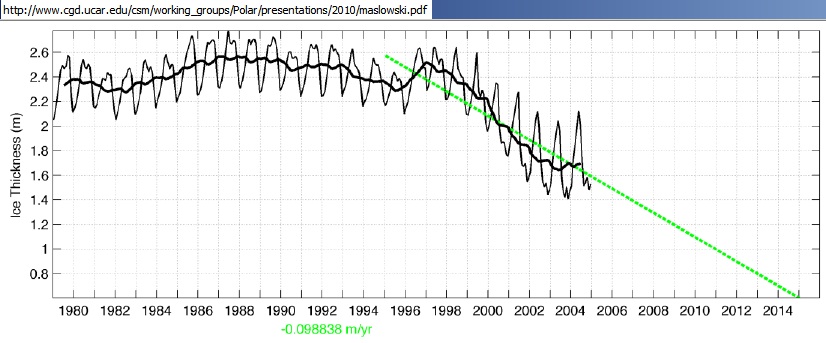 http://www.cgd.ucar.edu/csm/working_groups/Polar/presentations/2010/maslowski.pdf
http://www.cgd.ucar.edu/csm/working_groups/Polar/presentations/2010/maslowski.pdf
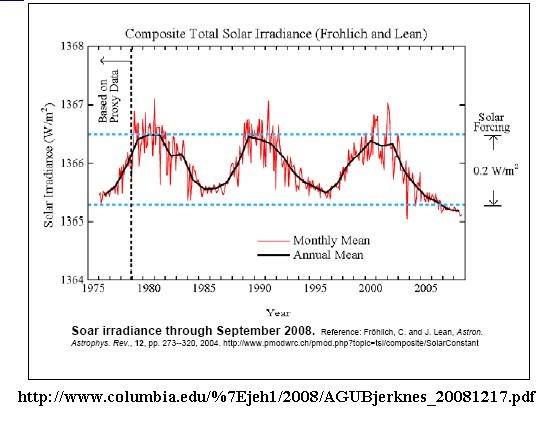 Increased warming in the next years when coming out of the current solar minimum:
Increased warming in the next years when coming out of the current solar minimum:
“We are presently in the deepest most prolonged solar minimum in the period of satellite data…The direct climate forcing due to measured solar variability, about 0.2 W/m2, is comparable to the increase in carbon dioxide forcing that occurs in about seven years, using recent CO2 growth rates”
From: “The Temperature of Science”, James Hansen, Dec 2009www.columbia.edu/~jeh1
.
.
.
Impact of Arctic summer sea ice melt:
US prepares for ’snowmageddon’ round two
http://www.brisbanetimes.com.au/world/us-prepares-for-snowmageddon-round-two-20100209-noo7.html
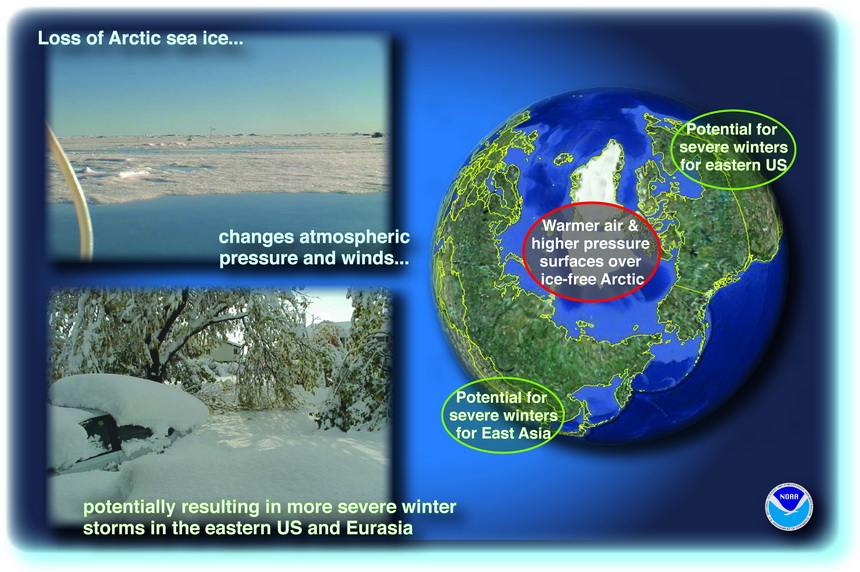 “Higher pressure surfaces above the North Pole, due to the warmer temperatures associated with greatly reduced sea ice, are thought to impact large scale wind patterns over the Northern Hemisphere. Climate models show these connections with cold air moving south, producing low pressure areas and unusually cold winters in the eastern U.S. and eastern Asia, and cooler than usual weather in late winter from Europe to the Far East.”
“Higher pressure surfaces above the North Pole, due to the warmer temperatures associated with greatly reduced sea ice, are thought to impact large scale wind patterns over the Northern Hemisphere. Climate models show these connections with cold air moving south, producing low pressure areas and unusually cold winters in the eastern U.S. and eastern Asia, and cooler than usual weather in late winter from Europe to the Far East.”
http://www.arctic.noaa.gov/future/impacts.html
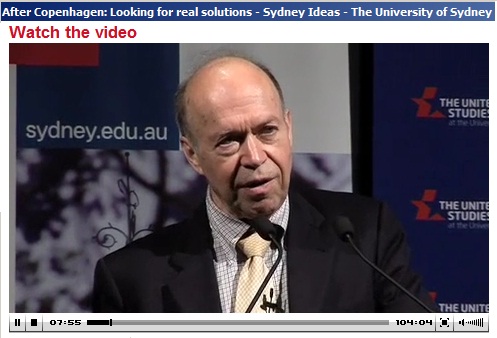 NASA climatologist James Hansen at Sydney Uni: “Australia doesn’t agree now that they got to stop their coal, but they are going to agree. I can guarantee you that within a decade or so because the climate change will become so strongly apparent that’s going to become imperative”
NASA climatologist James Hansen at Sydney Uni: “Australia doesn’t agree now that they got to stop their coal, but they are going to agree. I can guarantee you that within a decade or so because the climate change will become so strongly apparent that’s going to become imperative”
http://www.usyd.edu.au/sydney_ideas/lectures/2010/professor_james_hansen.shtml
This means the end of coal expansion and coal fired power plants. Power shortages are already pre-programmed.
(10) Assumed mining boom will get stuck in peak oil
“THE Labor government’s new population focus first needs to explain that a “big Australia” is a desirable and unavoidable byproduct of the rise of China and India”
That is theory. Let’s have a look at China’s oil demand growth:
Question: where will that extra 4 million barrels for the next 8 years come from? It took skyrocketing oil prices and a financial meltdown for OECD to “save” 5 mb/d:
Read: 21/2/2010 1st phase of peak oil caused demand destruction in OECD countries of around 5 mb/d
http://www.crudeoilpeak.com/?p=1149
(11) Sea level rises
CO2 currently in the atmosphere will result in a further warming of 0.6 degrees, practically doubling the warming of the last decades. Sea level rises over the next decades will mean a continuous rebuilding along transient coast lines. Many suburbs of our existing coastal cities will have to be moved, putting additional pressures on already overcrowded capital cities and limiting the capacity to accommodate a growing population. Note that a half metre sea level rise may already come over the next 40 years. These are the sea level rise estimates (up to 1.8 m by 2100) from Prof. Stefan Rahmstorf (Potsdam Climate Impact Research):
http://www.pik-potsdam.de/~stefan/Publications/Journals/vermeer_rahmstorf_2009.pdf
This is Tweed Heads with a 1.1 m sea level rise:
(12) Conclusion: The period of freely selecting immigration levels will soon be over, due to oil shortages. It is completely academic to discuss any planned immigration program for the period after 2020 and even more unrealistic to do any infrastructure planning on the basis of such population projections.
The immediate requirement until 2020 is to provide for a population increase of 1.1 million (natural growth), if immigration is cut to zero immediately and 1.9 million if current immigration is reduced to 60 K pa, which was the level during the early 90s recession.
Even for these estimates it is not clear where the finance will come from for housing this additional population.
In the decades to come, climate change refugees will arrive at Australia’s Northern shores in yet incalculable numbers, but they will settle there under 3rd world conditions as Australia will not be able to cope with that influx. If properly managed, they will establish agriculture there. A sea level rise of 0.5 m means 20-30 million homeless Bangladeshis, for example.
Urban infrastructure in capital cities for these refugees will definitely not be needed as Australia’s coastal cities will struggle with resettling their own population.
——————-
Further reading:
The intricacies of defining what net overseas migration is:
http://www.abs.gov.au/ausstats/abs@.nsf/mf/3412.0.55.001#2.%20CURRENT%20METHODS%20FOR%20ESTIMATING
3416.0 – Perspectives on Migrants, 2009
http://www.abs.gov.au/AUSSTATS/abs@.nsf/Lookup/3416.0Main+Features32009
ABS Migration 2007/08 #3412
http://www.ausstats.abs.gov.au/Ausstats/subscriber.nsf/0/33A138F3B3CD34C7CA25760000175284/$File/34120_2007-08.pdf
Migration as a policy tool to manage the global economic crisis
from Andrew Metcalf, Secretary Immigration
http://www.immi.gov.au/about/speeches-pres/_pdf/2009-09-03-anzsog-slides.pdf
.
